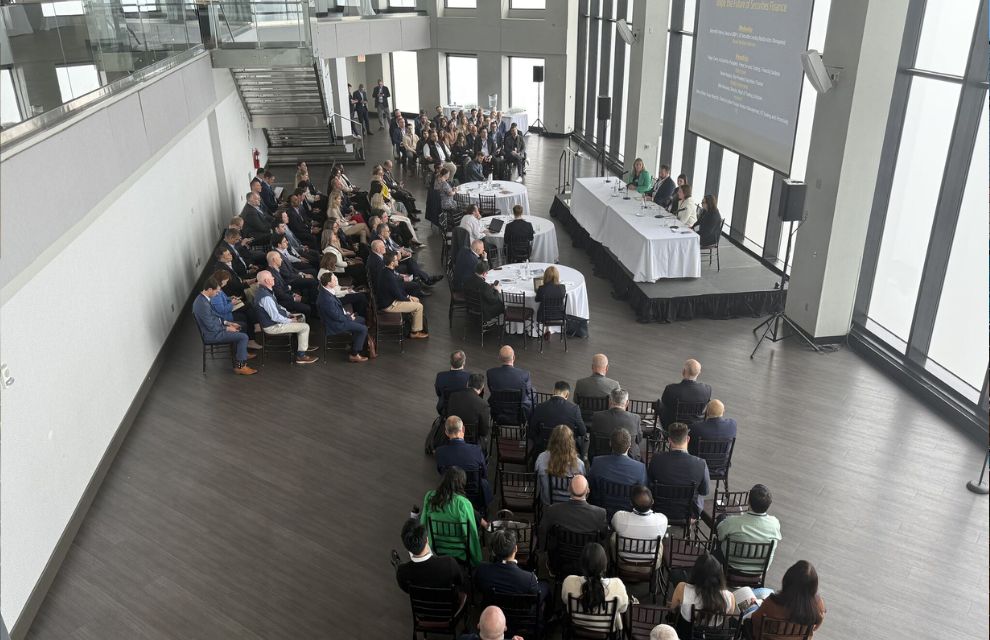SFS: Innovation and the future of securities finance
06 May 2025 US
 Image: Justin Lawson
Image: Justin Lawson
Setting the tone for the panel, and the day as a whole, Meredith Roderick, head of BBH’s US Securities Lending Relationship Management, kicked off the ‘How Innovation and New Perspectives Will Shape the Future of Securities Finance’ discussion as moderator, asking the audience: “What are the first words you think of when hear ‘innovation’?”
After the audience discussed the ideas among themselves and the hubbub died down, Paige Carey, assistant vice president, prime services trading, finance solutions at State Street, highlighted one word with which the panel agreed — automation.
A key theme with automation, emphasised by Carey and reiterated by the rest of the panel, is its ability to take care of lower-value work, freeing up individuals and resources for those higher-value tasks that can not, and should not, be automated.
Mike Norwood, director, head of trading solutions at State Street, added to this, emphasising the importance of relationships in the business. When automation can free up time, that is more time to spend working with people.
Brooke Hughes, vice president, Securities Finance at Fidelity Investments also highlighted the benefit that when you remove manual processes — and potentially human errors — you also reduce risk.
Norwood did, however, offer one caveat, in that there should not be automation for automation's sake, but rather one needs to look at the problems that you want to solve first.
Moving next to the topic of how you find innovative ideas, and when you have, how do you move them forward, Nancy Steiker, senior director, global securities finance product management, FIS Trading and Processing, acknowledged the benefit of fresh eyes, often from younger members of the team.
An established person often does not question what they have always known. A new person, she noted, can ask the question: ‘Why are we doing this this way?’
Leadership, Norwood suggested, has to be willing to listen, and to foster an environment where the team know this. It is, however, a two-way street — the team also has to be willing to speak up and offer ideas.
The panel agreed, while Hughes made the point, that firms need to be curious, question the status quo, and look toward the future.
Turing once again to the audience, Roderick asked, what are organisations doing, or what should they be doing, to encourage the mindset of innovation?
Mirroring the earlier narrative of the panel, one audience member reiterated the need for management to encourage innovation. Another participant raised the idea of bravery — bravery to listen to ideas, bravery to adopt ideas, and the bravery to suggest new ways of doing things. The panel agreed.
Looking next at how you get buy-in with innovative ideas, Steiker emphasised the importance of coming to management with well-thought-out ideas. Speak to clients first, she suggested, bringing solid case studies and examples of how it will help and why it is needed.
Taking another tack, though Norwood agreed about the benefit of those fully-formed ideas, he said it is important for management to have the willingness to look at those not yet fully-fledged. These ‘half-baked’ ideas can be pushed, encouraged, and developed.
Carey added to the idea, noting that if people are willing to come to you with the half-baked ideas, then there will be an environment where people will come to you with the full-baked ones as well.
Finally addressing the drivers and roadblocks of innovation, Hughes summarised the challenges quickly: changing regulation, new technologies, and cross-organisational dependencies.
Vendor fragmentation was another issue highlighted by the panel. Touching on a topic much-discussed at the event last year, Steiker pointed out that the move to T+1 in many ways drove such vendor integration.
Ending the discussion as it started, asking the audience for their thoughts, risk was shouted out as a string driver. If there is a real and current risk that innovation can solve, it soon gets looked at. As a challenge, another audience member noted another factor which came as no surprise to anyone — budget.
After the audience discussed the ideas among themselves and the hubbub died down, Paige Carey, assistant vice president, prime services trading, finance solutions at State Street, highlighted one word with which the panel agreed — automation.
A key theme with automation, emphasised by Carey and reiterated by the rest of the panel, is its ability to take care of lower-value work, freeing up individuals and resources for those higher-value tasks that can not, and should not, be automated.
Mike Norwood, director, head of trading solutions at State Street, added to this, emphasising the importance of relationships in the business. When automation can free up time, that is more time to spend working with people.
Brooke Hughes, vice president, Securities Finance at Fidelity Investments also highlighted the benefit that when you remove manual processes — and potentially human errors — you also reduce risk.
Norwood did, however, offer one caveat, in that there should not be automation for automation's sake, but rather one needs to look at the problems that you want to solve first.
Moving next to the topic of how you find innovative ideas, and when you have, how do you move them forward, Nancy Steiker, senior director, global securities finance product management, FIS Trading and Processing, acknowledged the benefit of fresh eyes, often from younger members of the team.
An established person often does not question what they have always known. A new person, she noted, can ask the question: ‘Why are we doing this this way?’
Leadership, Norwood suggested, has to be willing to listen, and to foster an environment where the team know this. It is, however, a two-way street — the team also has to be willing to speak up and offer ideas.
The panel agreed, while Hughes made the point, that firms need to be curious, question the status quo, and look toward the future.
Turing once again to the audience, Roderick asked, what are organisations doing, or what should they be doing, to encourage the mindset of innovation?
Mirroring the earlier narrative of the panel, one audience member reiterated the need for management to encourage innovation. Another participant raised the idea of bravery — bravery to listen to ideas, bravery to adopt ideas, and the bravery to suggest new ways of doing things. The panel agreed.
Looking next at how you get buy-in with innovative ideas, Steiker emphasised the importance of coming to management with well-thought-out ideas. Speak to clients first, she suggested, bringing solid case studies and examples of how it will help and why it is needed.
Taking another tack, though Norwood agreed about the benefit of those fully-formed ideas, he said it is important for management to have the willingness to look at those not yet fully-fledged. These ‘half-baked’ ideas can be pushed, encouraged, and developed.
Carey added to the idea, noting that if people are willing to come to you with the half-baked ideas, then there will be an environment where people will come to you with the full-baked ones as well.
Finally addressing the drivers and roadblocks of innovation, Hughes summarised the challenges quickly: changing regulation, new technologies, and cross-organisational dependencies.
Vendor fragmentation was another issue highlighted by the panel. Touching on a topic much-discussed at the event last year, Steiker pointed out that the move to T+1 in many ways drove such vendor integration.
Ending the discussion as it started, asking the audience for their thoughts, risk was shouted out as a string driver. If there is a real and current risk that innovation can solve, it soon gets looked at. As a challenge, another audience member noted another factor which came as no surprise to anyone — budget.
NO FEE, NO RISK
100% ON RETURNS If you invest in only one securities finance news source this year, make sure it is your free subscription to Securities Finance Times
100% ON RETURNS If you invest in only one securities finance news source this year, make sure it is your free subscription to Securities Finance Times



.jpg)